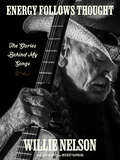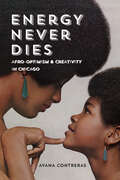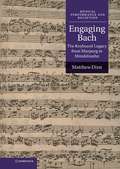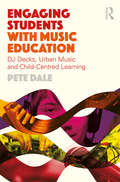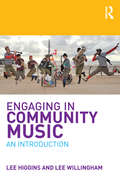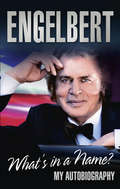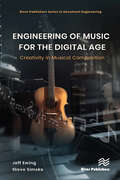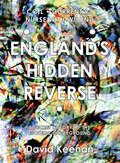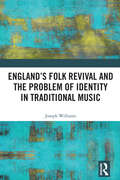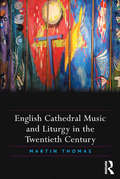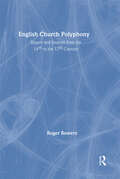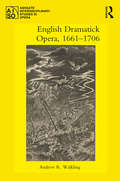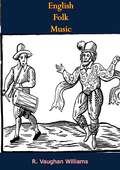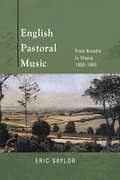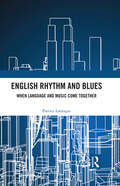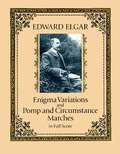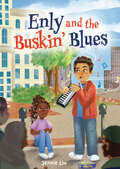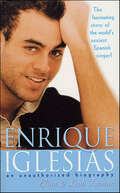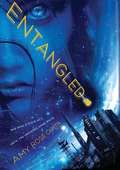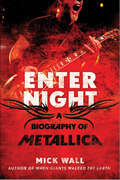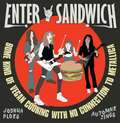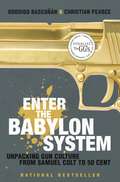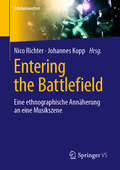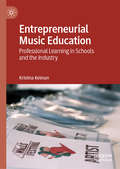- Table View
- List View
Energy Follows Thought: The Stories Behind My Songs
by David Ritz Willie Nelson Mickey RaphaelRevealing, funny, whimsical, and wise, outlaw country legend Willie Nelson shares the untold stories behind the his favorite songs, with all the lyrics and a dynamic assortment of never-before-seen photos and ephemera.From his earliest work in the 1950s to today, Willie looks back at the songs that have defined his career, from his days of earning $50 each to his biggest hits, from his less well-known songs (but incredibly meaningful to him) to his concept albums. Along the way, he also shares the stories of his guitar Trigger, his family and “family,” as well as the artists he collaborated with, including Patsy Cline, Waylon Jennings, Ray Charles, Merle Haggard, Ray Price, Dolly Parton, and many others.Willie is disarmingly honest—what do you have to lose when you’re about to turn 90? —meditating on the nature of songwriting and finding his voice, and the themes he’s explored his whole life—relationships, infidelity, love, loss, friendship, and, of course, life on the road.
Energy Never Dies: Afro-Optimism and Creativity in Chicago
by Ayana ContrerasFrom Afro Sheen to Theaster Gates and from Soul Train to Chance the Rapper, Black Chicago draws sustenance from a culture rooted in self-determination, aspiration, and hustle. In Energy Never Dies, Ayana Contreras embarks on a journey to share the implausible success stories and breathtaking achievements of Black Chicago's artists and entrepreneurs. Past and present generations speak with one another, maintaining a vital connection to a beautiful narrative of Black triumph and empowerment that still inspires creativity and pride. Contreras weaves a hidden history from these true stories and the magic released by undervalued cultural artifacts. As she does, the idea that the improbable is always possible emerges as an indestructible Afro-Optimism that binds a people together. Passionate and enlightening, Energy Never Dies uses the power of storytelling to show how optimism and courage fuel the dreams of Black Chicago.
Engaging Bach
by Matthew DirstMore than any other part of Bach's output, his keyboard works conveyed the essence of his inimitable art to generations of admirers. The varied responses to this repertory – in scholarly and popular writing, public lectures, musical composition and transcription, performances and editions – ensured its place in the canon and broadened its creator's appeal. The early reception of Bach's keyboard music also continues to affect how we understand and value it, though we rarely recognize that historical continuity. Here, Matthew Dirst investigates how Bach's music intersects with cultural, social and music history, focusing on a repertory which is often overshadowed in scholarly and popular literature on Bach reception. Organized around the most productive ideas generated by Bach's keyboard works from his own day to the middle of the nineteenth century, this study shows how Bach's remarkable and long-lasting legacy took shape amid critical changes in European musical thought and practice.
Engaging Haydn: Culture, Context, and Criticism
by Mary Hunter Richard WillHaydn is enjoying renewed appreciation as one of the towering figures of Western music history. This lively collection builds upon this resurgence of interest, with chapters exploring the nature of Haydn's invention and the cultural forces that he both absorbed and helped to shape and express. The volume addresses Haydn's celebrated instrumental pieces, the epoch-making Creation and many lesser-known but superb vocal works including the Masses, the English canzonettas and Scottish songs and the operas L'isola disabitata and L'anima del filosofo. Topics range from Haydn's rondo forms to his violin fingerings, from his interpretation of the Credo to his reading of Ovid's Metamorphoses, from his involvement with national music to his influence on the emerging concept of the musical work. Haydn emerges as an engaged artist in every sense of the term, as remarkable for his critical response to the world around him as for his innovations in musical composition.
Engaging Students with Music Education: DJ decks, urban music and child-centred learning
by Pete DaleEngaging Students with Music Education is a groundbreaking book about using DJ decks and urban music in mainstream schools to re-engage disaffected learners and develop a curriculum which better reflects overall contemporary tastes. Many young learners are ‘at risk’ of exclusion; this book argues that for such individuals, the implications of such a shift in the music curriculum could be especially positive. Drawing extensively on the author’s own wealth of teaching experience, and bridging the gap between practice and theory, this book demonstrates through case studies that DJ decks can prove extremely valuable in mainstream classroom situations across the secondary school age ranges. Addressing challenging and crucial topics, combining rigorous theoretical analysis with practical suggestions, the book addresses questions such as: Are DJ decks actually a musical instrument, and are they suitable for classroom teaching? Will Ofsted's school inspectors approve of music teaching involving DJ decks and urban music? If we bring urban music into the classroom, will this further marginalise classical music? Are DJing and MCing skills recognised within examination specifications, at least in the UK? Current teachers will find the practical advice on how to incorporate DJ decks and urban music into their classroom especially helpful, whilst educational researchers will be captivated by the critical discussion of the child-centred tradition and a theoretical approach which stretches from ‘continental’ philosophy to practice-based reflection. With an insistence that the starting point for music education should always be the interests and experiences of the learners, this book is essential reading for those music teachers and researchers interested in the benefits of non-standard music-making in the classroom.
Engaging in Community Music: An Introduction
by Lee Higgins Lee WillinghamEngaging in Community Music: An Introduction focuses on the processes involved in designing, initiating, executing and evaluating community music practices. Designed for both undergraduate and graduate students, in community music programmes and related fields of study alike, this co-authored textbook provides explanations, case examples and ‘how-to’ activities supported by a rich research base. The authors have also interviewed key practitioners in this distinctive field, encouraging interviewees to reflect on aspects of their work in order to illuminate best practices within their specialisations and thereby establishing a comprehensive narrative of case study illustrations. Features: a thorough exploration and description of the emerging field of community music; succinctly and accessibly written, in a way in which students can relate; interviews with 26 practitioners in the US, UK, Australia, Europe, Canada, Scandinavia and South Africa, where non-formal education settings with a music leader, or facilitator, have experienced success; case studies from many cultural groups of all ages and abilities; research on life-long learning, music in prisons, music and ritual, community music therapy, popular musics, leisure and recreation, business and marketing strategies, online communities – all components of community music.
Engelbert - What's In A Name?: My Autobiography
by Engelbert HumperdinckThe man known simply as 'Enge' by his millions of fans worldwide has sold over 150 million records and is in the Guinness Book of Records for achieving 56 consecutive weeks in the chart with 'Release Me'.From living on the dole and receiving last rites with tuberculosis, to buying a Hollywood palace with a heart-shaped pool and a fleet of fourteen Rolls Royces, Engelbert wears his 'King of Romance' crown so well that horticulturists even named a rose after him. And the love god has certainly lived up to his reputation, indulging in a string of affairs and one-night stands, whilst remaining happily married to his first love Patricia. Forty years on from his early hits 'Enge' is still at the very top, selling out concerts across the world, representing the UK at the 2012 Eurovision Song Contest, and topping the charts in all the major markets.Inspired by the warmth of his millions of affectionate fans and the endless support of his wife, Engelbert shares his incredible life story with openness, humour and astonishing honesty.
Engineering of Music for the Digital Age: Creativity in Musical Composition
by Steven Simske Jeffrey EwingMusical scores – like literature, poetry, and technical manuals – are documents. The central tenet of this book is that musical composition in the digital age is a form of document engineering. In essence, music shares with other forms of creative content generation – from poetry to prose, and from science to science fiction – the need for structure, flow, and sources for creativity.Musical composition is considered in this book as the creative process of engineering musical documents with regards to its arrangement, form, texture, and instrumentation, etc. This "document" then instructs a performance or the creation of an alternative document, such as a recording. In this book, the arrangement of phrases, patterns, and structures seen in music will be illustrated to give new composers a starting point to begin planning and making decisions about their own compositions.The book will also guide those who need assistance in completing a piece. While this is a book about musical composition, it is not meant to be a manual on music theory. Instead, the book keeps its focus on the structural elements of a composition. Its aim is to give the audience a structural road map for composing; whether they are starting a piece from the first note, having a melody in mind already, or need help overcoming a creative hurdle. The book examines compositions that clearly define a form or technique. Among the key compositional elements are: Form, Phrase, Period, and Expression in Composition Rhythm/Motive Melody and Harmony Tonal Center Mode Mixture and Modulation Accompaniment/Instrumentation/Orchestration Composition Techniques and Notation Targeted examples cover all stages of writing a piece, helping to build the reader’s composition from the first note into a complete work without promoting a style or harmonic practice. Each chapter contains a sidebar addressing helping the composer to add creative sources for the music making process. Finally, the book concludes with a chapter on creativity in terms of how composed music can affect our lives and even our fairy tales.
England's Hidden Reverse, revised and expanded edition: A Secret History of the Esoteric Underground
by David KeenanAn expanded edition of the classic exploration of the English esoteric musical underground—with the first biography of Coil, Current 93, and Nurse With Wound.This newly expanded edition of England's Hidden Reverse, the classic exploration of the English esoteric musical underground that includes the first, and only, biographies of Coil, Current 93, and Nurse With Wound, is based on exclusive interviews and unprecedented access to all three bands&’ personal archives. Together, these genre-defying bands and their circles represent the English underground in all its cultural, artistic, and sexual variety. Over four decades, the three intertwined groups have maintained a symbiotic, yet uneasy, relationship with the mainstream of popular culture, even as their music, beliefs, and practices have repelled them from it. Theirs was a clandestine scene whose work accents the many occulted peculiarities of Englishness that flow through generations of outsiders, channeling personalities as diverse as Aleister Crowley, Arthur Machen, Joe Orton, Shirley Collins, Björk, and Marc Almond. The story of this Hidden Reverse has, necessarily, remained a secret. Until now. This new volume contains almost 100 pages of extra material culled from Furfur, a collection of interviews with musicians and artists whose careers intersected with the bands&’, initially published alongside Strange Attractor's first limited edition of the book.
England’s Folk Revival and the Problem of Identity in Traditional Music
by Joseph WilliamsEstablishing an intersection between the fields of traditional music studies, English folk music history and the philosophy of Gilles Deleuze and Félix Guattari, this book responds to the problematic emphasis on cultural identity in the way traditional music is understood and valued. Williams locates the roots of contemporary definitions of traditional music, including UNESCO-designated intangible cultural heritage, in the theory of English folk music developed in 1907 by Cecil Sharp. Through a combination of Deleuzian philosophical analysis and historical revision of England’s folk revival of the Victorian and Edwardian eras, Williams makes a compelling argument that identity is a restrictive ideology that runs counter to the material processes of traditional music’s production. Williams reimagines Sharp’s appropriation of Darwinian evolutionary concepts, asking what it would mean today to say that traditional music ‘evolves’, in light of recent advances in evolutionary theory. The book ultimately advances a concept of traditional music that eschews the term’s long-standing ontological and axiological foundations in the principle of identity. For scholars and graduate students in musicology, cultural studies, and ethnomusicology, the book is an ambitious and provocative challenge to entrenched habits of thought in the study of traditional music and the historiography of England’s folk revival.
English Cathedral Music and Liturgy in the Twentieth Century
by Martin ThomasThis book examines the stylistic development of English cathedral music during a period of liturgical upheaval, looking at the attitudes of cathedral clergy, liturgists, composers, leading church music figures and organisations to music and liturgy. Arguments that were advanced for retaining an archaic style in cathedral music are considered, including the linking of musical style with liturgical language, the recommending of a subservient role for music in the liturgy, and the development of a language of fittingness to describe church music. The roles of the RSCM and other influential bodies are explored. Martin Thomas draws on many sources: the libraries and archives of English cathedrals; contemporary press coverage and the records of church music bodies; publishing practices; secondary literature; and the music itself. Concluding that an arresting of development in English cathedral music has prevented appropriate influences from secular music being felt, Thomas contrasts this with how cathedrals have often successfully and dynamically engaged with the world of the visual arts, particularly in painting and sculpture. Presenting implications for all denominations and for patronage of the arts by churches, and the place of musical aesthetics in the planning of liturgy, this book offers an important resource for music, theology, liturgy students and ministry teams worldwide.
English Church Polyphony: Singers and Sources from the 14th to the 17th Century (Variorum Collected Studies)
by Roger BowersThe theme of the essays in this volume is the identification of the resources which between c.1320 and 1642 the English church saw fit to provide for the performance of the music of its liturgy. Individual essays describe the music and the choirs of Canterbury and Lincoln Cathedrals, Winchester Cathedral Priory and the private chapel of Cardinal Wolsey, while the personnel of the chapels of Edward III, the Black Prince and John of Gaunt emerge from study of the texts of compositions of the 14th century. From the alignment of contemporary musical and archival sources there arises a web of conclusions relating to the size of ensemble, vocal scoring and sounding pitch envisaged by its composers for English church polyphony of the period c.1320-1559. These essays thus encompass the two most profound of the revolutions to which the music of the English church was subject at this period: the inauguration and widespread adoption of choral polyphony in the years c.1455-85 and the liturgical and doctrinal Reformation of 1547 to 1563.
English Dramatick Opera, 1661–1706 (Ashgate Interdisciplinary Studies in Opera)
by Andrew R. WalklingEnglish Dramatick Opera, 1661–1706 is the first comprehensive examination of the distinctively English form known as "dramatick opera", which appeared on the London stage in the mid-1670s and lasted until its displacement by Italian through-composed opera in the first decade of the eighteenth century. Andrew Walkling argues that, while the musical elements of this form are crucial to its definition and history, the origins of the genre lie principally in a tradition of spectacular stagecraft that first manifested itself in England in the mid-1660s as part of a hitherto unidentified dramatic sub-genre, to which Walkling gives the name "spectacle-tragedy". Armed with this new understanding, the book explores a number of historical and interpretive issues, including the physical and rhetorical configurations of performative spectacle, the administrative maneuverings of the two "patent" theatre companies, the construction and deployment of the technologically advanced Dorset Garden Theatre in 1670–71, the critical response to generic, technical, and ideological developments in Restoration drama, and the shifting balance between machine spectacle and song-and-dance entertainment throughout the later decades of the seventeenth century, including in the dramatick operas of Henry Purcell. This study combines the materials and methodologies of music history, theatre history, literary studies, and bibliography to fashion an entirely new approach to the history of spectacular and musical drama on the English Restoration stage. This book serves as a companion to the Routledge publication Masque and Opera in England, 1656–1688 (2017).
English Folk Music
by R. Vaughan WilliamsIn this short monograph, composer R. Vaughan Williams discusses English folk-songs and looks at three examples with music and commentary.The composer Ralph Vaughan Williams was one of the musicians who participated in the first English Folk Song revival, as well as using folk song tunes in his compositions. He collected his first song, Bushes and Briars, from Mr Charles Pottipher, a seventy-year-old labourer from Ingrave, Essex in 1903, and went on to collect over 800 songs, as well as some singing games and dance tunes. For 10 years he devoted up to 30 days a year to collecting folk songs from singers in 21 English counties, though Essex, Norfolk, Herefordshire and Sussex account for over two thirds of the songs in his collection. He recorded a small number of songs using a phonograph but the vast majority were recorded by hand. He was a regular contributor to the Folk Song Society's Journal, a member of the society's committee from 1904 to 1946, and when in that year the society amalgamated with the English Folk Dance Society he became president of the English Folk Dance and Song Society, a position he held until his death.
English Pastoral Music: From Arcadia to Utopia, 1900-1955
by Eric SaylorCovering works by popular figures like Ralph Vaughan Williams and Gustav Holst as well as less familiar English composers, Eric Saylor's pioneering book examines pastoral music's critical, theoretical, and stylistic foundations alongside its creative manifestations in the contexts of Arcadia, war, landscape, and the Utopian imagination. As Saylor shows, pastoral music adapted and transformed established musical and aesthetic conventions that reflected the experiences of British composers and audiences during the early twentieth century. By approaching pastoral music as a cultural phenomenon dependent on time and place, Saylor forcefully challenges the body of critical opinion that has long dismissed it as antiquated, insular, and reactionary.
English Rhythm and Blues: Where Language and Music Come Together
by Patrice Paul LarroquePatrice Larroque hypothesizes that early blues singers may have been influenced by the trochaic rhythm of English. English is stressed and timed, which means that there is a regular beat to the language, just like there is a beat in a blues song. This regular beat falls on important words in the sentence and unimportant ones do not get stressed. They are “squeezed” between the salient words to keep the rhythm. The apparent contradiction between the fundamentally trochaic rhythm of spoken English and the syncopated ternary rhythm of blues may be resolved as the stressed syllables of the trochee (a stressed-unstressed sequence) is naturally lengthened and assumes the role of one strongly and one weakly stressed syllable in a ternary rhythm. The book suggests investigating the rhythm of English and the rhythm of blues in order to show how the linguistic rhythm of a culture can be reflected in the rhythm of its music.
Enigma Variations and Pomp and Circumstance Marches in Full Score
by Edward ElgarAuthoritative British editions of the 14 Variations, rich with melody and vibrant rhythms, each revealing a facet of a central theme never fully expressed and each depicting an unnamed friend of the composer. Four of the 5 stirring Pomp and Circumstance Marches are included here as well. Filled with a distinctively English grandeur, they are popular everywhere and have been frequently recorded.
Enly and the Buskin' Blues
by Jennie LiuTwelve-year-old Enly Wu Lewis is determined to go to band camp and follow in the footsteps of his musician father, who died years ago. But his mom, a single parent working two jobs, is saving every penny for his older brother's college tuition. So Enly sets out to earn the money for camp on his own, by busking with an obscure instrument he can only kind of play. When someone drops a winning scratch-off lottery ticket into his tip box, Enly thinks it's the answer to his problems—but he'll have to overcome teenage thieves and his own family if he wants to achieve his dreams.
Enrique Iglesias: An Unauthorized Biography
by Leah Furman Elina FurmanSon of the Latin singing legend Julio Iglesias, Enrique has his own sexy style and his own kind of sound. Born in Spain, he's hit the charts big time and captured hearts around the world. But Enrique is more than just a major hottie-he's got the talent and ambition to stay on top.Find out all about this gorgeous Spanish singer, from his love life to his family life, how he feels about success (as the bestselling Latin recording artist in the world!) and his famous dad, what he likes to do in his free time, and much, much more!
Entangled
by Amy Rose CapettaAlone was the note Cade knew best. It was the root of all her chords. Seventeen-year-old Cade is a fierce survivor, solo in the universe with her cherry-red guitar. Or so she thought. Her world shakes apart when a hologram named Mr. Niven tells her she was created in a lab in the year 3112, then entangled at a subatomic level with a boy named Xan. Cade's quest to locate Xan joins her with an array of outlaws--her first friends--on a galaxy-spanning adventure. And once Cade discovers the wild joy of real connection, there's no turning back.
Enter Night: A Biography of Metallica
by Mick WallTheir roots lie in the heavy rock of 70s groups like Deep Purple. The music they played—heavy metal mixed with punk attitude—became its own genre: thrash. Their bassist died and they survived to became the biggest-selling band in the world. As grunge threatened to overtake them, they reinvented themselves. Then their singer went into rehab and they almost fell apart. They are Metallica, the most influential heavy metal band of the last thirty years.As Led Zeppelin was for hard rock and the Sex Pistols were for punk, Metallica became the band that defined the look and sound of 1980s heavy metal. Inventors of thrash metal—Slayer, Anthrax and Megadeth followed—it was always Metallica who led the way, who pushed to another level, who became the last of the superstar rockers.Metallica is the fifth-largest selling artist of all time, with 100 million records sold worldwide. Their music has extended its reach beyond rock and metal, and into the pop mainstream, as they went from speed metal to MTV with their hit single "Enter Sandman". Until now there hasn't been a critical, authoritative, in-depth portrait of the band. Mick Wall's thoroughly researched, insightful work is enriched by his interviews with band members, record company execs, roadies, and fellow musicians. He tells the story of how a tennis-playing, music-loving Danish immigrant named Lars Ulrich created a band with singer James Hetfield and made his dreams a reality. Enter Night follows the band through tragedy and triumph, from the bus crash that killed their bassist Cliff Burton in 1986 to the 2004 documentary Some Kind of Monster, and on to their current status as the leaders of the Big Four festival that played to a million fans in Britain and Europe and continues in the U.S. in 2011. Enter Night delves into the various incarnations of the band, and the personalities of all key members, past and present—especially Ulrich and Hetfield—to produce the definitive word on the biggest metal band on the planet.
Enter Sandwich: Some Kind of Vegan Cooking with No Connection to Metallica
by Joshua PloegOh, aging rockers. We've all seen them struggle to get along and cope with life. Maybe they just need to sit around a backyard picnic table, share a vegan feast, and talk about their feelings. After all, to live is to stir fry. Automne Zingg, genius mastermind behind Comfort Eating with Nick Cave and Defensive Eating with Morrissey is back with hilarious illustrations of the band's revolving cast eating their feelings and expressing their enthusiasm for food, but in a tough and intense way. "Yeahms!" sings James, riffing on a giant yam. Zingg's work is coupled with the inventive and flavorful recipes of chef and queercore punk musician, Joshua Ploeg. Written in lyrical form, the recipes parody 40 of the most quintessential tunes. Crank up the volume while concocting plant-based recipes like Master of Nuggets, Pie of the Beholder, an All Nightmare Footlong, or maybe just a little stock. So let it be eaten. (Just don't try to illegally download this book.)
Enter the Babylon System: Unpacking Gun Culture from Samuel Colt to 50 Cent
by Christian Pearce Rodrigo BascunanA docu-style investigation of our fascination with the gun, from the perspective of the hip-hop generation.The 2003 shooting death of Toronto community-centre worker Kempton Howard put the spotlight on hip hop's fixation with guns. Media and police soon blamed rap music and its tales of gang life on bullet-ridden US streets for the rising use of firearms in Canadian crime. Were these songs artful accounts of a terrible truth, or a self-fulfilling prophecy?Rodrigo Bascunan and Christian Pearce have interviewed many of the major players in the hip-hop world. As publishers of an award-winning magazine of urban culture, they'd watched rap music become a scapegoat for society's much older and widely spread fascination with guns. What follows is their international adventure to deconstruct modern gun culture in all its manifestations. Bascunan and Pearce seek out hip-hop artists, illegal gun runners, firearms aficionados and manufacturers, museum curators, academics, politicians, video-game creators, activists, victims of gun violence and the family and friends left behind.Somewhere between Fast Food Nation, No Logo and a Michael Moore documentary, featuring sly sidebar material and original artwork, Enter the Babylon System is part outrageous journalistic pursuit and part passionate cri de coeur for sanity in the face of a society's obsession.From the Hardcover edition.
Entering the Battlefield: Eine ethnographische Annäherung an eine Musikszene (Erlebniswelten)
by Johannes Kopp Nico RichterModerne Gesellschaften bestehen aus einer Vielzahl von Lebenswelten. Diese besitzen aber spezifische kulturelle Eigenheiten, die sich einem Verständnis und somit auch einer wissenschaftlichen Erfassung von außen teilweise entziehen. Szenen dienen dabei als hilfreiches Konzept, um diese gesellschaftlich relevanten Gebilde fassbar zu machen. Hierzu bedarf es zunächst einer Annäherung und Beschreibung der kulturellen Eigenheiten aus der Binnenperspektive. Gegenstand des vorliegenden Buches ist die Szene des Heavy-Metal bzw. ihre Manifestation im Rahmen eines Festivals. Mit Hilfe ethnographischer Methoden werden die unterschiedlichsten szenespezifischen Phänomene anhand konkreter Situationen – etwa in den unterschiedlichsten Formen des Campens über ritualisierte Verhaltensweisen, das spezifische Konsumverhalten und die äußere Erscheinung der Protagonisten bis hin zur erstaunlichen Neigung zu beinahe konservativen Wertvorstellungen – beschrieben und untersucht. Zudem soll abschließend in einem Exkurs zu einer gänzlich anderen Szene gezeigt werden, wie viele erstaunliche Parallelen sich hinsichtlich der szenischen Vergemeinschaftung im Allgemeinen finden lassen.
Entrepreneurial Music Education: Professional Learning in Schools and the Industry
by Kristina KelmanThis book addresses the gap between formal music education curricula and the knowledge and skills necessary to enter the professional music industry. It uses extensive data from a long-running research project where high school students were invited to start their own business venture, Youth Music Industries. Not only did this act as a business venture, but it also functioned as a learning environment informed by the concepts of Communities of Practice and social capital. Exploring how entrepreneurial qualities were developed, their learning was subsequently captured and distilled into a set of design principles: in this way, a pedagogical approach was developed that can be transferred across the creative industries more broadly. This book will be of interest and value to scholars of music education, as well as those preparing students for the creative industries.
